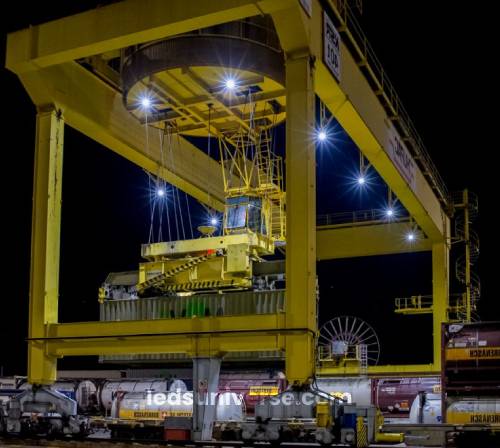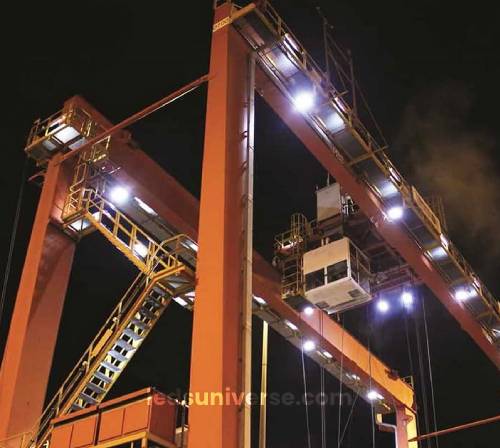From the broad illumination that lights up the entire workspace to focused task lighting for those critical details, and advanced LED solutions that offer energy efficiency and durability, crane lighting systems are tailored to meet diverse needs. Ready to light up your crane operations? Let’s illuminate the details!
By providing clear illumination for crane operations, it not only helps in reducing potential hazards but also significantly enhances overall productivity. Enhanced visibility under various conditions, such as low light or adverse weather, further contributes to smoother and more efficient operations, ultimately supporting the success of industrial and construction projects.
Reach out for free lighting consultation
Table of Contents
ToggleCrane lighting systems are designed to meet the specific requirements of different applications and environments, ensuring optimal performance and safety. The primary types of crane lighting include:
General illumination provides comprehensive lighting to the entire area surrounding the crane. This type of lighting is essential for creating a well-lit environment, which helps operators and workers avoid accidents and complete tasks more efficiently. General illumination often involves high-intensity lighting solutions such as floodlights or high-bay LED fixtures. These lights are strategically positioned to ensure that all areas within the crane’s operational zone are adequately illuminated, reducing shadows and increasing overall visibility.

Task lighting is designed to focus light on specific areas where detailed and precise work is conducted. For cranes, task lighting typically targets the load area, the crane’s hook, or other components where accurate operations are necessary. This type of lighting often employs adjustable spotlights or floodlights that can be directed to illuminate the exact location needed. Task lighting enhances the visibility of critical work areas, allowing operators to perform their tasks with greater accuracy and confidence. By providing concentrated illumination where it is most needed, task lighting helps to improve the efficiency and safety of crane operations.
This type of lighting includes features such as warning lights, strobe lights, and reflective markers, which are used to alert personnel to the crane’s presence and movements. Safety lighting is crucial for preventing accidents by making the crane more visible to both operators and other workers in the vicinity. It helps to enhance situational awareness and reduce the risk of collisions or other incidents. Effective safety lighting contributes to a safer working environment by ensuring that the crane’s operations are clearly visible and that personnel are aware of potential hazards.
LED lighting is rapidly gaining popularity in crane lighting applications due to its numerous advantages over traditional lighting options. LED lights are known for their energy efficiency, providing bright and consistent illumination while consuming less power. This results in lower energy costs and reduced environmental impact. Additionally, LEDs have a longer lifespan compared to conventional lights, which means they require less frequent replacement and maintenance. Their durability makes them particularly well-suited for harsh operating conditions, such as extreme temperatures or exposure to dust and moisture. LED lighting also offers improved performance in terms of light quality and distribution, making it an ideal choice for crane operations where reliable and efficient illumination is essential.
Designing an effective crane lighting system is a multifaceted task that requires careful consideration of several critical factors to ensure optimal performance, safety, and operational efficiency. Key design considerations include:
The required lighting levels for crane operations are contingent on the specific tasks being performed and the operational environment. Adequate illumination must be provided to ensure that all critical areas, including the load, hooks, and surrounding workspace, are thoroughly lit. The goal is to achieve uniform lighting coverage to eliminate shadows and dark spots, which can pose hazards and hinder work efficiency. Effective lighting levels enhance visibility, reduce the risk of accidents, and allow for precise handling of loads. A well-designed lighting system should be tailored to meet the specific needs of the operation, whether it involves intricate lifting tasks or broad-area lighting for general visibility.
Crane lighting systems must be engineered to withstand a range of environmental conditions that can affect lighting performance and longevity. Factors such as temperature extremes, high humidity, dust, and exposure to chemicals must be accounted for in the design process. For outdoor cranes, lighting fixtures should be weatherproof and capable of enduring adverse weather conditions such as rain, snow, and high winds. These fixtures often feature robust enclosures and sealing mechanisms to protect against water ingress and corrosion. In contrast, indoor cranes operating in dusty environments may require lights with sealed enclosures to prevent the accumulation of debris and ensure consistent performance. By addressing these environmental challenges, the lighting system can maintain reliability and effectiveness under varying conditions.
Properly designed lighting systems prevent excessive glare, which can impede visibility and create a hazardous working environment. Fixtures equipped with appropriate shielding and diffusers play a significant role in controlling glare and providing a comfortable and safe working environment. Achieving balanced light distribution helps maintain clear visibility and supports accurate operations, reducing the likelihood of errors and accidents. Additionally, well-distributed light contributes to a more pleasant and productive work environment for crane operators and other personnel.
Secure and reliable electrical connections are fundamental to the system’s performance and safety. This includes implementing appropriate wiring, circuit protection, and connection points to accommodate the lighting system’s demands. Furthermore, incorporating backup power systems, such as generators or uninterruptible power supplies (UPS), is vital to maintain illumination during power outages or disruptions. These backup systems ensure continuous operation and safety, particularly in critical applications where consistent lighting is crucial.

Regular upkeep and timely enhancements are crucial for keeping the lighting system in top condition and maximizing its effectiveness in crane operations.
Routine inspections are a fundamental aspect of crane lighting system maintenance. Regular checks help identify and address potential issues before they escalate into major problems that could disrupt operations or pose safety hazards. Inspections should encompass various components of the lighting system, including light fixtures, electrical connections, and control systems. During these inspections, it is important to assess the physical condition of fixtures, look for signs of wear or damage, and evaluate the functionality of electrical connections and controls. Any issues, such as loose wiring, cracked fixtures, or malfunctioning controls, should be promptly addressed to ensure continuous and reliable operation. By proactively identifying and resolving problems, routine inspections contribute to the overall safety and efficiency of crane operations.
Over time, light fixtures, lenses, and reflectors can accumulate dust, dirt, and other contaminants that can diminish light output and lead to overheating. Regular cleaning of these components helps to maintain optimal lighting performance and extend the lifespan of the fixtures. Cleaning procedures should involve removing accumulated debris, wiping down surfaces, and ensuring that lenses and reflectors are free from obstructions. Additionally, it is important to regularly check and replace worn-out or damaged bulbs and other components. Replacing faulty or degraded parts ensures that illumination remains at the required levels and helps prevent safety issues caused by insufficient lighting. Timely replacement of parts not only maintains lighting efficiency but also enhances the overall safety of the work environment.
Advancements in lighting technology offer substantial benefits, including improved energy efficiency, enhanced brightness, and greater durability. Upgrading to modern lighting technologies, such as LED systems, can significantly impact operational costs and performance. LEDs are known for their high energy efficiency, which translates into lower energy consumption and reduced utility bills. They also offer longer lifespans compared to traditional lighting options, leading to fewer replacements and lower maintenance costs. Additionally, LED lighting provides superior light quality, with better color rendering and brightness, which enhances visibility and reduces glare. Incorporating the latest lighting technologies should be part of a strategic approach to crane operations, aligning with evolving industry standards and technological advancements. By investing in upgrades, organizations can improve the overall effectiveness of their crane lighting systems, adapt to changing operational needs, and ensure a safer and more efficient working environment.
By understanding the different types of crane lighting, considering key design factors, and implementing regular maintenance and upgrades, organizations can optimize their crane operations and reduce the risk of accidents. Investing in high-quality, well-designed lighting solutions not only enhances visibility and safety but also contributes to overall productivity and operational success.